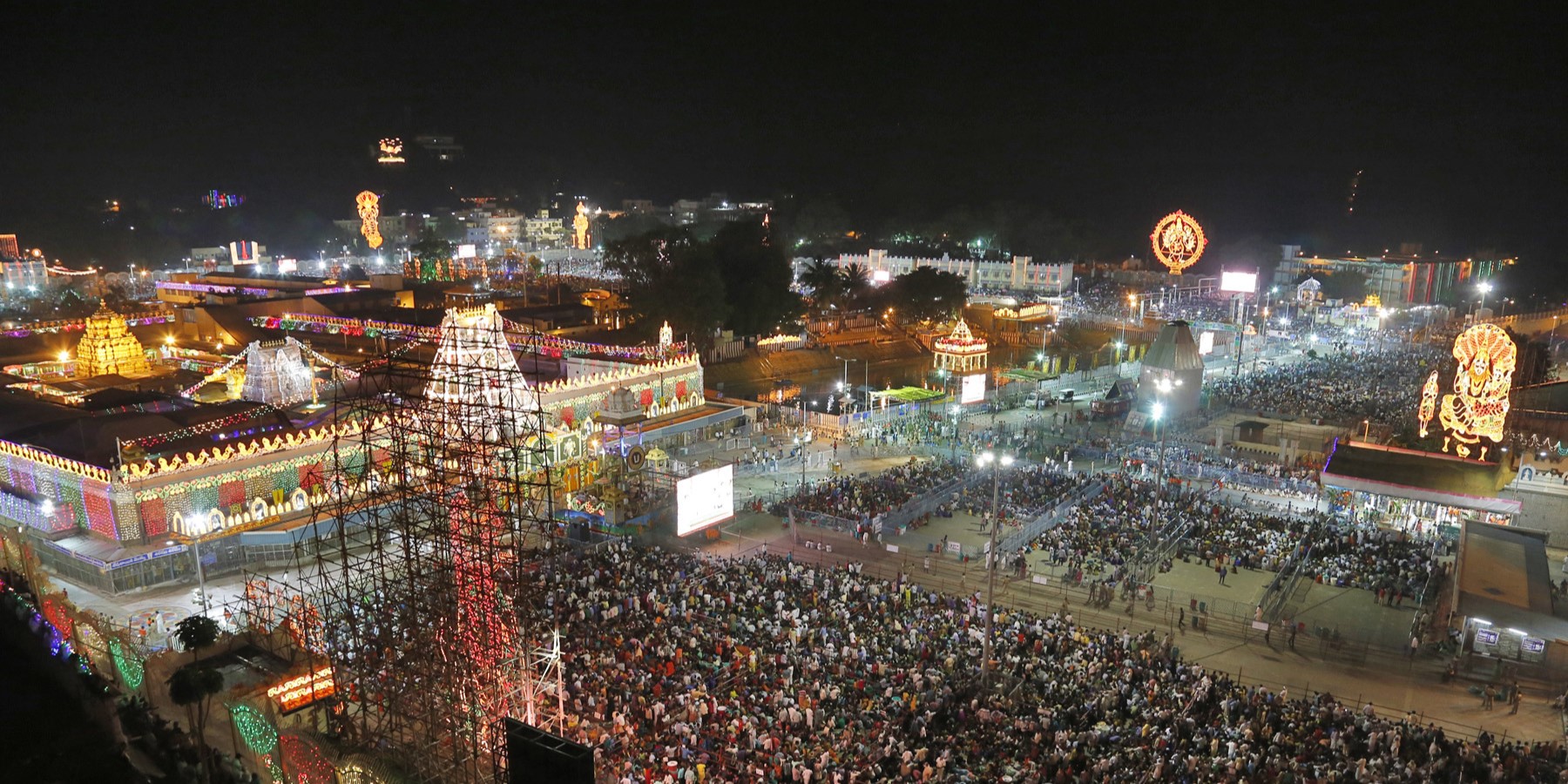The drone visuals that surfaced on social media two days ago sparked a major controversy due to the sentiments attached to the temple.

The Tirupati Sri Venkateswara Temple. (Official website)
People are up in arms. Some Tirumala Tirupati Devasthanams (TTD) top executives say it is the work of the employees of a private firm engaged to carry out a solid-waste management survey. Others claim miscreants put together 3D images.
And all of it because aerial footage of the Ananda Nilayam of the Tirupati Sri Venkateswara Temple appeared online!
The controversy started after footage surfaced on social media over the weekend.
It sparked a major controversy due to the sentiments attached to one of the richest Hindu temples and triggered security concerns.
According to Vaikhanasa Agama Shastras, metal objects are forbidden from flying atop the main sanctum sanctorum of the temple in Tirumala — the “Ananda Nilayam”.
Though the airspace above the Tirumala temple was never officially declared a no-fly zone by Central agencies like the DGCA, airlines tend to avoid the route above the Ananda Nilayam owing to the sentiments of the devotees.
But there’s more to it: Why are metal objects not allowed over the temple?
All the rituals and seva at Tirumala Sri Venkateswara Swamy Temple, which is also called Sri Vari Temple, are performed strictly in accordance with the rules and principles laid down several thousand years ago by the sage Vaikhanasa.
The manual, called Vaikhanasa Bhagavath Agama Shastra, guides all the rituals currently performed at the Sri Vari Temple every day.
As per this Agama Shastra, many gods, goddesses, Gandharvas and holy angels are constantly standing in prayers and — from the skies or from the celestial world — having an “Aroopa Darsana”, or a view of the formless Lord Venkateswara, residing on the Tirumala hills.
The Agama Shastras say, “All these divine personalities are constantly gazing at Him with great reverential attention.”
Keeping this aspect of divinity on the Tirumala hills in view, the Vaikhanasa principles prohibit any Vimanas — metal flying objects — from travelling in between these celestial devotees and Lord Venkateswara.
That means no flying object or aircraft is allowed to fly over either the Tirumala temple or over the seven hills of Tirumala.
The TTD has already ordered a probe into the videos, and also sent them for forensic study.
“Not sure if those videos are real or fake, and it will be known only after the forensic report. An agency was engaged to conduct a survey last year. Not sure if the staff of that private agency shot the visuals using a drone,” TTD Executive Officer (EO) AV Dharma Reddy said.
He also suspected that such visuals could be made using Google 3-D images.
Sources in TTD said that an aerial survey was done last November after permission from the Anna Dana Nilayam and Kakula Guda dumping yard.
“As per the Agama Shastra, no such recordings with drone cameras at Sri Vari Temple have been done to date,” said TTD Chairman YV Subba Reddy.
“TTD vigilance officials have already sent the videos to the forensic lab for fact-finding. After we receive the reports within two or three days, we will take stern legal action against the Hyderabad-based social media network which has allegedly morphed the 3D video and made it into a drone video, and inform the devotees how some miscreants are playing with their sentiments with such fake and tailored videos,” he added.
TTD Chief Vigilance and Security Officer (CVSO) P Narasimha Kishore said that the entirety of the Tirumala hills was under the eagle eye of hi-fi vigilance and security, and it was not possible to capture any video there through a drone camera.
He also warned of legal action against the persons who videographed the Tirumala temple.
In 2012, the Andhra Pradesh government headed by N Kiran Kumar Reddy and the then TTD board requested the Central government to declare the airspace above the Tirumala temple a no-fly zone.
In 2015, the state government reiterated its appeal during P Ashok Gajapathi Raju’s tenure as Union civil aviation minister.
But, the DGCA turned down the request in 2016 and made it clear that the ancient hill town could not be declared a no-fly zone.
“Due to terrain constraints around the Tirupati airport, it is already restricted to single-runway operations. Any additional restrictions in the form of a no-fly zone over the Tirumala hills will further reduce the accessibility to such an important airport,” Minister of State for Civil Aviation Jayant Sinha told Rajya Sabha in a written in July 2016.
The DGCA earlier turned down similar pleas from the Lord Jagannath Temple in Puri of Odisha and the Sri Padmanabha Swamy Temple in Kerala.
The TTD is planning to introduce a Naval Anti-Drone System (NADS) in Tirumala soon. Such a system is said to be able to instantly detect and jam micro-drones.
“The negotiations are going on with Bharat Electronics Limited (BEL) over the procurement of a NADS. As a part of introducing a secured transportation mechanism for pilgrim luggage, the TTD is going for a state-of-the-art luggage-tagging system that will come into force likely by this April-end. Akin to the airport model, we are going for RFID tagging of the luggage of pilgrims,” Dharma Reddy.
After a drone attack on an air force base in Jammu in June 2021, the then TTD CVSO Gopinath Jetty attended a demonstration of an anti-drone system at Kolar in Karnataka by the DRDO.
The system reportedly offers a detection capability of up to 4 km, with a “soft kill” option by way of radio frequency jamming, which disables communication.
It is also said to have features like a GPS-spoofing-cum-jamming system that works on neutralising the remote locating system in a drone.

Apr 24, 2024

Apr 24, 2024

Apr 24, 2024

Apr 24, 2024

Apr 24, 2024

Apr 24, 2024